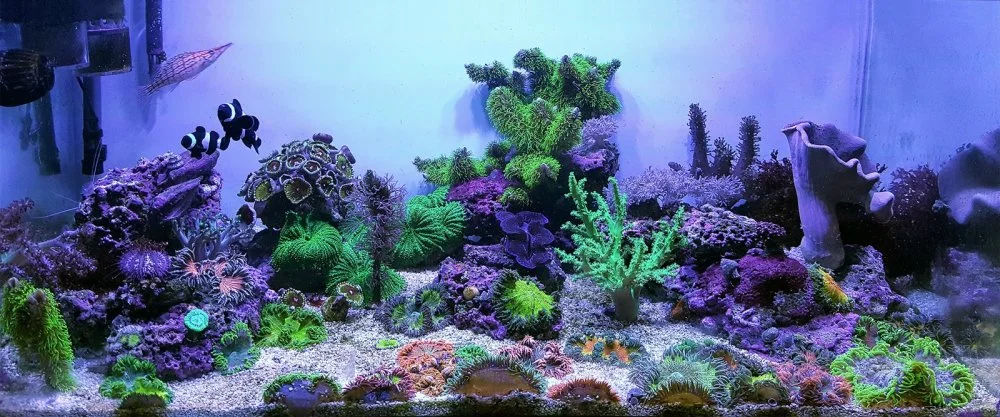Stunning 40-Gallon Reef Tank – FlowerMama's TOTM | NanoReef

Tank Specifications
Volume: 40 Gallons / 151 Liters
Dimensions (L × W × H):
36.0" ×
18.0" ×
16.0"
91.4cm ×
45.7cm ×
40.6cm
Equipment List
No equipment information available
Frequently Asked Questions
What type of lighting is best for a nano reef tank?
For a nano reef tank, it's essential to use high-quality lighting that can support coral and other sensitive marine life. The NanoBox Quad with a BlueFish Controller is an excellent option, as it allows for customizable lighting schedules and intensity, crucial for fostering a healthy growth environment for your corals and anemones.
How much live rock should I have in my reef tank?
Generally, you should aim for about 1 to 1.5 pounds of live rock per gallon of water in your reef tank. For a 40-gallon tank like this one, approximately 35 to 40 pounds of Gulf Live Rock is adequate, providing the necessary structure for coral placement and habitat for fish and invertebrates.
What is the ideal maintenance routine for a reef tank?
A simple yet effective maintenance routine includes cleaning the glass almost daily with a razor, using a turkey baster to fluff up the sand and remove debris, and vacuuming sand in specific areas. It is recommended to perform water changes once a month, but transitioning to bi-weekly water changes can significantly enhance tank health. Additionally, clean your skimmer on a monthly basis to ensure efficient filtration.
How should I feed the fish and corals in my reef tank?
Fish and coral should be fed a varied diet to ensure optimal health. Offer fish jumbo mysis shrimp, frozen fish, scallops, and Omega pellets. For corals, consider regular feedings of specialized foods like Coral Frenzy, Phyto, Oyster Feast, and Reef Bugs to promote growth and vitality.
What types of fish are suitable for a 40-gallon reef tank?
In a 40-gallon reef tank, hardy and relatively peaceful fish are preferred. In this setup, Ocellaris Clownfish and Longnose Hawkfish are both excellent options as they are compatible with most reef environments and can thrive well without being aggressive toward other species.
How can I care for rock flower anemones?
Rock flower anemones require specific care to thrive. Ensure they have sufficient lighting and stable water parameters. Hand feed them a variety of foods such as mysis shrimp and other quality marine proteins. Regularly monitor water quality and avoid overcrowding to prevent stress.
What should I do if my reef tank experiences a cyano or dino outbreak?
If you encounter a cyano or dino outbreak, it's crucial to address the imbalance in nutrients and lighting. Increase tank aeration, reduce light intensity, and do more frequent water changes. Additionally, consider introducing cleanup crews or products designed to combat these outbreaks, and avoid overfeeding to help stabilize the environment.
How can I maintain water quality in my reef tank?
To maintain good water quality, regularly test for parameters like salinity, pH, ammonia, nitrite, nitrate, and phosphates. Use quality freshwater for top-offs and changes. Creating your own saltwater mix, rather than relying on store-bought, can save costs and allow you to control the ingredients more effectively.